
|
Student's Study Guide for LessonThree
by Dr Jamie Love |

|
 and
and  licensed under a Creative Commons Attribution-ShareAlike 4.0 International License.
licensed under a Creative Commons Attribution-ShareAlike 4.0 International License.

|
Student's Study Guide for LessonThree
by Dr Jamie Love |

|
Mitosis is specifically designed to distribute _____ and ____ amounts of genetic material so the daughter cells are genetically _________ to each other (and the mother nucleus that they came from) - ______.
Mitosis increases the number of ______ and that usually leads to an increase in cell numbers too.
Species that reproduce this way are clones and this method of reproduction is called _______ reproduction. Clones are produced without sex and without _______. Plants are "masters" at cloning and that is why asexual reproduction is often called __________ reproduction or vegetative ___________.
Mitosis is a flow of events but we have divided it into four obvious stages
During prophase the chromatin condenses into ___________.
This is the distinguishing characteristic of prophase - _______,
___________ chromosomes (a "ball of _____"). Prophase
is a rather long process and is often divided into _____ and ____
prophase.
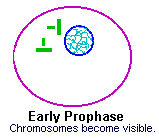
| During prophase, as the chromosomes continue to condense, the centrosomes move to opposite "_____" dragging their spindles along. |
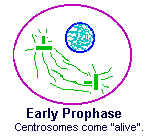
|
|
Eventually the cell enters late prophase and, because the next
phase will be metaphase, late prophase is often call ____________.
During prometaphase two very important events occur.
|
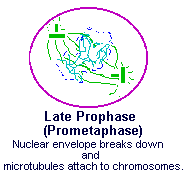
|
|
Late in prophase two special structures grows inside of the centromere region of every chromosome - one on each _________. These structures are called ____________. ("Kinetos" is Greek for "movement".) The kinetochore attaches to the __________ that make up the spindles from the centrosomes. Once attached, the spindles run from _________ (one on each chromatid) to the _________ (one on each side), so each chromosome is held between the two centrosomes via the ________. |
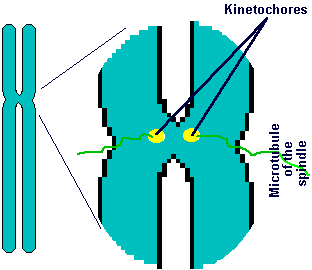
|

|
A series of tugging from both kinetochores on their spindles cause
the chromosomes to move back and forth until this "tug-of-war"
ends in a "draw" - the chromosome is then positioned
______ between the centrosomes.
___ the chromosomes behave this way. |
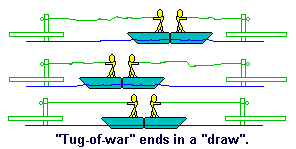
|
|
Therefore, all the chromosomes come to line up midway between
the two ___________.
When all the chromosomes' centromeres are lying on a plane _____________ to a line connecting the two centrosomes, the cell has entered the part of mitosis called _________. The plane upon which the centromeres are arranged is called the _________ _____. |
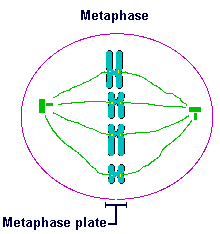
|
Metaphase lasts for about an hour and is the ____ time to see chromosomes.
|
At ________ the centromere of each chromosome breaks down
the middle (!) and the two sister __________ move to opposite centrosomes.
It is at anaphase that "true" _______ division occurs. |
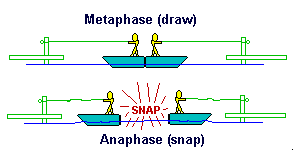
|
|
As each kinetochore drags its chromatid along, the arms of the
chromatid are swept back and they seem to form a __-shaped structure.
All the chromosomes are able to coordinate the breaking of their centromeres quite well and the speed at which the chromatids move is impressive so anaphase is a sight to see! (In a ______ cell, of course.) |

|

|
The moment the chromosome's centromere splits (during ________)
each kinetochore acts as the center for the creation of a new
centromere.
Each chromatid is "puckered" inward at the kinetochore during anaphase and that is the new __________. The trick to counting chromosomes and differentiating them from chromatids is to keep track of the __________. A chromosome has a single centromere and each chromosome has two kinetochores at the centromere - one on each _________. |
|
By definition a chromosome has a centromere - it's a __
to __ correspondence. During anaphase, each chromosome becomes
two separate chromosomes at that moment of chromatid _________
and we now have two chromosomes from each chromosome!
During anaphase and until cytokinesis occurs, the cell has _____ as many chromosomes as "normal". | 
|
Once the newly created chromosomes reach their poles, anaphase
is ____ and we enter the next and last phase of mitosis - _________.
"Telo" is Greek for "end.
|
Telophase is the point in mitosis when the new ______ are
formed. A nuclear membrane forms around both bundles of chromosomes
at each ____. This creates two nuclei.
Also, the chromosomes begin to ______ (decondense) until eventually they are nothing more than a dim coloring of chromatin with a few nucleoli (clumps of chromatin). Each nucleus takes on the appearance of an interphase nucleus and once that is done the cell has completed telophase and _______. | 
|
Telophase produced the identical nuclei that we now call ________ nuclei because they will be the nuclei of the daughter cells produced from the upcoming cytokinesis.
|
Not only are the daughter nuclei identical to each other but they
are also identical to the ______ nucleus from which they came.
The daughter nuclei are clones of each other and clones of their
mother nucleus.
Also, notice that a (mother) cell must have ___ centrosomes in order to orchestra mitosis, but both (daughter) cells produced (after cytokinesis) have only __ centrosome each (until they enter late __ and the whole cycle starts again). | 
|